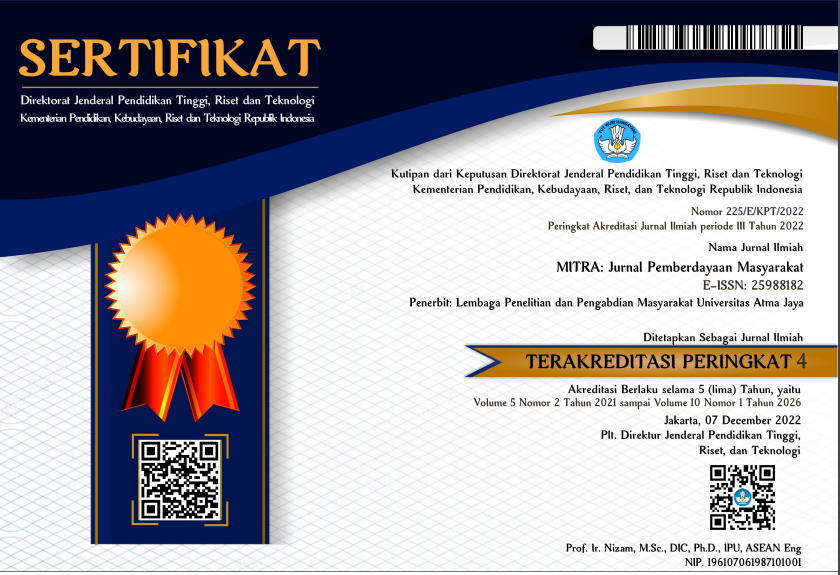Introducing Sleep Hygiene to the Church of Sidang Jemaat Allah Bethlehem Congregation, Bogor, West Java
DOI:
https://doi.org/10.25170/mitra.v5i1.1806Keywords:
GSJA Bethlehem, insomnia, sleep hygieneAbstract
Insomnia is one of the most common health problems. Approximately one-third of adults show symptoms related to insomnia. Around 9%-15% of people have sleeping disorders dan suffer the consequences of it in the daytime, and roughly 6% suffer from diagnosed insomnia. Although the prevalence and significant effects of insomnia have been known, sleep disorders are still rarely diagnosed and receive proper treatments. Lack of sleep will create sleep debt that the body will have to compensate for by adding more sleep time in the next day. Should this compensation fail to be fulfilled, the individual will suffer from excessive sleepiness, memory problems, difficulty concentrating, and disturbances in performing daily activities. Chronic lack of sleep can also decrease memory and cognitive abilities, trigger mood disorders and even cause hallucination. The Sidang Jemaat Allah Bethlehem church (GSJA) is one of the biggest churches in Bogor. The people of GSJA’s knowledge of healthy sleep patterns and their sleep quality was unknown. Therefore, it was necessary to provide sleep health education to raise the awareness of the importance of healthy sleep patterns, both the quantity and the quality, in practicing a healthy lifestyle. We also assessed their sleep quality using the Pittsburgh Sleep Quality Index (PSQI) questionnaire. The data show that out of 41 participants, 30 of them (73.11%) have poor sleep quality (score ≥ 5) and most of them were in the 71-80-year-old age group. The participants' level of understanding about sleep hygiene has increased after the event.
References
Garret, B., Hough, G., & Agnew, J. (2015). Brain and behavior (4th ed.). SAGE.
Grandner, M. A. (2019). Chapter 2 - Epidemiology of insufficient sleep and poor sleep quality (M. A. B. T.-S. and H. Grandner (ed.); pp. 11–20). Academic Press. https://doi.org/https://doi.org/10.1016/B978-0-12-815373-4.00002-2.
Guo, H., Wei, M., & Ding, W. (2017). Changes in cognitive function in patients with primary insomnia. Shanghai Archives of Psychiatry, 29(3), 137–145. https://doi.org/10.11919/j.issn.1002-0829.216097.
Hirshkowitz, M., Whiton, K., Albert, S. M., Alessi, C., Bruni, O., DonCarlos, L., Hazen, N., Herman, J., Katz, E. S., Kheirandish-Gozal, L., Neubauer, D. N., O’Donnell, A. E., Ohayon, M., Peever, J., Rawding, R., Sachdeva, R. C., Setters, B., Vitiello, M. V, Ware, J. C., & Adams Hillard, P. J. (2015). National sleep foundation’s sleep time
duration recommendations: Methodology and results summary. Sleep Health, 1(1), 40–43. https://doi.org/https://doi.org/10.1016/j.sleh.2014.12.010.
Kay, D. B., & Buysse, D. J. (2017). Hyperarousal and beyond: New insights to the pathophysiology of insomnia disorder through functional neuroimaging studies. In Brain Sciences.7(3). https://doi.org/10.3390/brainsci7030023.
Pigeon, W. R., Bishop, T. M., & Krueger, K. M. (2017). Insomnia as a precipitating factor in new onset mental illness: A systematic review of recent findings. Current Psychiatry Reports, 19(8), 44. https://doi.org/10.1007/s11920-017-0802-x.
Purves, D., Augustine, G. J., Fitzpatrick, D., Hall, W. C., & LaMantia, A.-S. (2018). Neuroscience (6th ed.). Sinauer Associates.
Riemann, D., Baglioni, C., Bassetti, C., Bjorvatn, B., Dolenc Groselj, L., Ellis, J. G., Espie, C. A., Garcia-Borreguero, D., Gjerstad, M., Gonçalves, M., Hertenstein, E., JanssonFröjmark, M., Jennum, P. J., Leger, D., Nissen, C., Parrino, L., Paunio, T., Pevernagie, D., Verbraecken, J.,Spiegelhalder, K. (2017). European guideline for the diagnosis and
treatment of insomnia. Journal of Sleep Research, 26(6), 675–700.https://doi.org/https://doi.org/10.1111/jsr.12594.
Ropper, A., & Samuel, M. (2019). Adam and victor’s: principles of neurology (11th ed.). McGraw Hill Companies.
Sherwood, L. (2013). Introduction to human physiology (8th ed.). Brooks/Cole Cengage Learning.
Treur, J. L., Gibson, M., Taylor, A. E., Rogers, P. J., & Munafò, M. R. (2018). Investigating genetic correlations and causal effects between caffeine consumption and sleep behaviours. Journal of Sleep Research, 27(5), e12695.
https://doi.org/https://doi.org/10.1111/jsr.12695.
Wardle-Pinkston, S., Slavish, D. C., & Taylor, D. J. (2019). Insomnia and cognitive performance: A systematic review and meta-analysis. Sleep Medicine Reviews, 48, 101205. https://doi.org/https://doi.org/10.1016/j.smrv.2019.07.008.
Downloads
Published
Issue
Section
License
This license allows reusers to distribute, remix, adapt, and build upon the material in any medium or format for noncommercial purposes only, and only so long as attribution is given to the creator. If you remix, adapt, or build upon the material, you must license the modified material under identical terms.



_.jpeg)

.png)
2.png)
.png)
.png)



